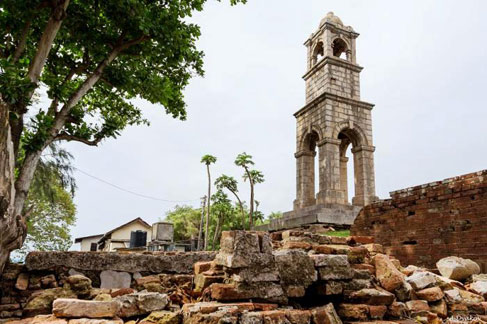|
Musings:
Christmastime in Little Rome
by Padma Edirisinghe
It is Buddhist Lanka. To be more accurate, the world more or less
recognizes it to be so. But there is a swathe of land spreading along
the Western coast that sports its own identity. The main city of this
swathe called Negombo is even dubbed the Little Rome, an epithet that
ultra nationalists disdain.
|

Old Dutch Fort, Negombo.
pic www.victoriatravels.lk |
What is rather intriguing about the name of this city is that it is
almost embedded in the bowels of our ancient history. The ancient
chronicles mention it as the home of a famous honey comb or beehive ie.
Meeya. Hence Meegomuwa. Queen Vihara Maha Devi, spouse of king
Kavanthissa (2nd C BC) while pregnant with Lanka's greatest king,
Dutugemunu, yearned to partake of it. And the king sent his men left and
right and
North and South to search for it.
Queen
One of the ten Dasa Maha Yodhayas (ten great giants) finally found it
attached to a boat on the Western seashore and the famous queen who once
faced the mighty ocean to quell a tsunami as the daughter of king
Kelanithissa of Kelaniya had her yearnings or Doladuka fulfilled which
ensured a safe delivery of the mighty prince. Thus was spawned the name,
Meegomuwa.
Strangely the present name Negombo by which the world of tourism
knows her has no connection whatsoever to the historical name. A
guessing game goes on as to the antecedents of the present name, Negombo,
that has even plunged into very mediocre guessing.
One is that white skinned tourists had once asked some natives as to
the name of this lovely place and the latter mistaking the query to be,
why the dogs on the sands keep barking so much elicited the answer,
Nikamboo, which meant 'Just barking'. So the name had got baptized in
this strange way among the foreigners.
Somersaults
Just as the name of the city had its somersaults so did the city.
Once a predominately Buddhist city just like any other city in Lanka
today one has to go into a tiresome quest to find a Buddhist temple
against the huge network of churches. Of course Angurukaramulla temple
still reigns along with the name of a benefactor in the neighbourhod. He
is Walisinghe Harischandra who dug up the buried city of Anuradhapura
and today he stands majestic in that city too.
Today, however it is crosses that dot the skyline of Negombo and they
articulate a massive conversion campaign that took place during the
Portuguese period. The Portuguese are known for their role in converting
a good part of the world into Xtianity and their zeal was not completely
religious. They had to maintain the powerful Pope as an ally and that
was purely political.
Conversion
But this race did not find conversion tactics in the inland easy. The
ferocious acts initiated by Portuguese commanders such as Azavedo only
made this merciful message of Christ unpopular.
This accounts for the fact that the area round Malwana where was
built in the salubrious terrain by the Kelani river, the palace for the
Commander, the new religion never grounded itself.
But it planted itself and spread in and around the Negombo area that
sociologists may attribute to the following reasons,
The patronage given to fishermen. Xtianity even has a patron saint
for them.
The five precepts of Buddhism acted a deterrent to the vocation of
fishermen.
The intensive conversion drive of the new administrators perpetuated
more by the role of the missionary schools
The system of gratifying the noblesse with tithes and lands if
converted.
That the new religion too included idol worship and the transfer of
allegiance was easy. Spilbergen, a Protestant and a Dutch comments on
this.
Fling
Before going into Negombo's fling with Roman Catholicism leading to
even being dubbed the little Rome it is relevant to mention her last
fling with local history. That is when a house by the Negombo waterfront
acted as a refuge for a fleeing king. The king was Sri Wicrema
Rajasinghe, the last king of Kandy and of Lanka too but masses were
rallying round the main route to Colombo to wreak vengeance on him for
his brutal acts and he opted to reach the coast in his carriage by an
unknown road after staying overnight in the house of Welle Mudali, the
chief of Negombo town, a Fernando and a converted Catholic. That house
in Wella Vidiya though today Americanized still goes by the name Sri
Wickrema and is still inhabited by the descending family of Fernandos.
Today most Negombians carry these Portuguese surnames such as
Fernando, Gomez and Boteju.
Just by Sri Wickrema looms the St. Sebastian Church and College and a
little distance away rises to the skies the cross of St. Peters church
and a bit beyond that of Ave Maria convent, the leading girls' school in
the area.
No doubt they spangle these days, in full glory to God in this little
Rome.
|

